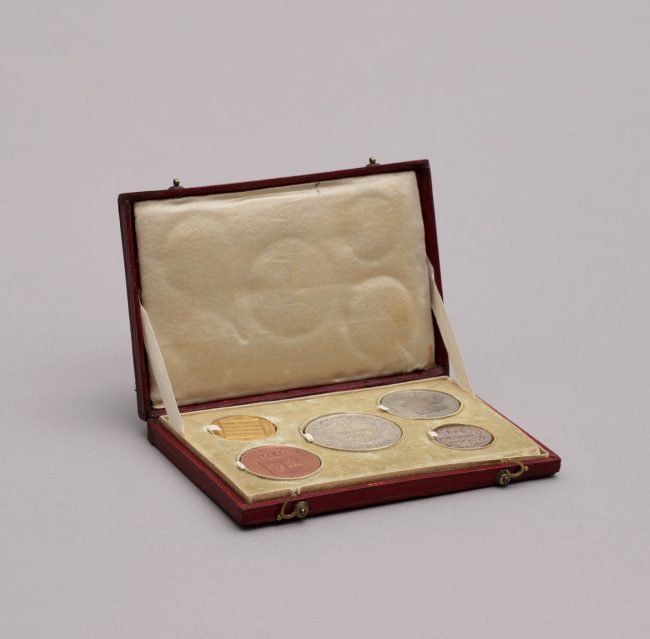
Case with a complete set of coins from the period of the November Uprising 1830–1831
The wooden case upholstered with silk and velvet has a special base with apertures that correspond to the size of all kinds of coins minted by the Warsaw Mint during the November Uprising (1830–1831) – the Polish national uprising against Russia, which seized the Polish territories during the Partitions between 1772 and 1795; the uprising broke out as a result of a conspiracy of Polish servicemen. What is more, two banknotes issued at the time by the Bank of Poland are inserted between the side of the case and the edge of the base. Coins of the denomination of one ducat (gold), five and two zlotys as well as ten grosz (silver) and three grosz (copper) were minted between March and September 1831, whereas one zloty banknotes, printed at Warsaw’s Banknote Factory, were issued by the Bank of Poland in the period between 1 August and 8 September 1831. The case was constructed for the very purpose of storing this collection. The cover features the image of Eagle and Pahonia, surrounded by panoplia. Inscription above the coat of arms reads: “On the day of 29 November 1830,” with a poem underneath: “Heavens announce the old prophecies of Lech/ Poles! This is our eagle, this is our land.” Moreover, the four sides feature gilded inscriptions with abbreviations of the names of towns that witnessed the most important battles of the Uprising: Grochów, Dębe Wielkie, Ostrołęka and Iganie.
The Bank of Poland was established in 1828 upon the initiative of the Minister of the Treasury of the Kingdom of Poland, Prince Franciszek Ksawery Drucki-Lubecki (1779–1846). It was a government institution that championed the economic development of the Kingdom of Poland – an ersatz of the Polish state formed after the Congress of Vienna (1815) on the territories of the Russian Partition and bound with Russia through a personal union. The Bank was also entitled to mint its coin and issue banknotes to the amount of the initial capital, yet prior to the November Uprising it only issued banknotes.
The Uprising broke out on the nigt of 29/30 November 1830, and on 9 December 1830 the Provisional Government appointed the Bank of Poland to manage the Warsaw Mint. The Mint operated since 1766 (with an interruption between 1796 and 1810), and since 1815 it minted coins with the coat of arms of the Kingdom of Poland: the double-headed eagle of the Russian Emperors with a shield with the Polish eagle on its chest. After the dethronement of Emperor Nicholas I Romanov (1796–1855, Emperor of Russia since 1825, King of Poland 1825–1831) by the Sejm during its proceedings in Warsaw on 25 January 1831, the coats of arms of Emperors were removed from the mint dies and Polish zlotys with Eagle and Pahonia (the coat of arms of the Polish-Lithuanian Commonwealth – state formed of the Crown of the Kingdom of Poland and the Grand Duchy of Lithuania (1569–1795) prior to the Partitions) were introduced into circulation.
Following the defeat of the November Uprising and abolition of the constitution of the Kingdom of Poland which resulted in its incorporation into the Russian Empire, authorities ordered to withdraw coins and banknotes from circulation, so storing them as souvenirs stood as an expression of the patriotic sentiments of their owners. The coins that had initially been stored in the case became dispersed and Ludwik Gocel was compelled to complement the collection, which he managed to achieve during the several years that immediately followed World War II (1939–1945).
Case with a complete set of coins from the period of the November Uprising
WARSAW MINT
WARSAW; MARCH–SEPTEMBER 1831
GOLD, SILVER, COPPER, WOOD, VELVET, PAPER
MHW 1060–1067/LG
7,3 × 10,9 × 1,4 CM
Image licensed under: ![]()
